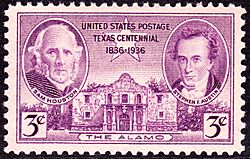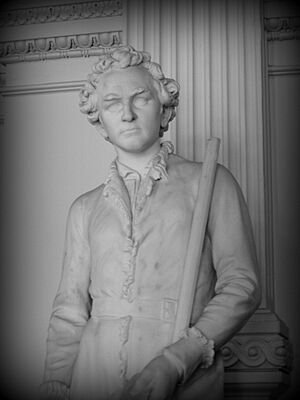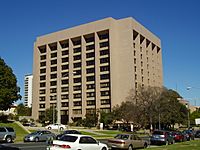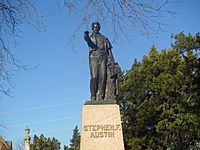Stephen F. Austin facts for kids
Quick facts for kids
Stephen F. Austin
|
|
|---|---|
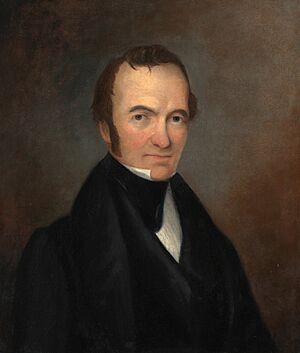
A portrait of Austin painted around 1840, after his death.
|
|
| 4th Secretary of State of Texas | |
| In office October 22, 1836 – December 27, 1836 |
|
| President | Sam Houston |
| Preceded by | William Houston Jack |
| Succeeded by | James Pinckney Henderson |
| Member of the Missouri Territorial Legislature |
|
| In office 1814–1820 |
|
| Personal details | |
| Born |
Stephen Fuller Austin
November 3, 1793 Wythe County, Virginia, United States (present-day Austinville, Virginia) |
| Died | December 27, 1836 (aged 43) West Columbia, Brazoria County, Republic of Texas |
| Nationality | American, Spanish, Mexican, Texian |
| Relations |
|
| Parents | Moses Austin, Mary Brown Austin |
| Occupation | Politician, empresario |
| Known for | Being the "Father of Texas" |
Stephen Fuller Austin (November 3, 1793 – December 27, 1836) was an American land agent. He is often called the "Father of Texas". This is because he founded the first successful colony of American settlers in the region.
In 1825, Austin brought 300 families from the United States to Tejas. Tejas was then a part of Mexico. These first families are famously known as the Old Three Hundred.
Austin was born in Virginia and grew up in Missouri. He served in the Missouri territorial legislature. His father, Moses Austin, first got permission from Spain to bring settlers to Texas.
After his father died, Stephen took over the plan. By this time, Mexico had won its independence from Spain. Austin had to get the new Mexican government to approve his father's original grant.
Austin successfully brought many American settlers to Texas. He tried to keep a good relationship with the Mexican government. He even helped stop an early rebellion. However, as more settlers arrived, they grew unhappy with Mexican rule. This led to the Texas Revolution.
Austin led Texas soldiers in the early part of the war. He later served as a diplomat to the United States. After Texas won its independence, he ran for president. He lost to Sam Houston. Houston made him the first Secretary of State of the Republic of Texas. Austin died in this role in December 1836. Many places, including the capital city of Austin, Texas, are named in his honor.
Contents
Stephen Austin's Early Life and Education
Stephen F. Austin was born on November 3, 1793. His birthplace was a mining area in Virginia. His parents were Mary Brown Austin and Moses Austin.
When he was five, his family moved to what is now Potosi, Missouri. There, they ran a lead mine.
At age eleven, Austin was sent to Connecticut for school. He later attended Transylvania University in Kentucky. He graduated in 1810. After college, he studied to become a lawyer.
When he was 21, Austin was elected to the Missouri Territory's legislature. He later moved to the new Arkansas Territory. There, he became a judge. After some challenges, he moved to New Orleans, Louisiana, in 1820. He continued studying law there.
Starting a New Life in Texas
While Austin was in Arkansas, his father Moses got a special grant from Spain. This grant allowed him to settle 300 American families in Texas. But Moses became very sick with pneumonia and died.
Before he died, Moses asked his son Stephen to take over the project. Stephen was unsure at first. But he agreed after receiving a letter from his mother.
Austin traveled to San Antonio to get his father's grant approved. On the way, he learned that Mexico had become independent from Spain. This meant Texas was now a Mexican province. The new government had to reauthorize the grant.
Governor Antonio María Martínez approved the plan. He allowed Austin to explore the land between San Antonio and the Brazos River. Austin needed to find a good spot for his colony.
Austin advertised his colony in New Orleans. He offered large amounts of land to families for a very low price. Farmers could get 177 acres. Ranchers could get 4,428 acres. In December 1821, the first American colonists arrived. They settled in what is now Brazoria County, Texas.
Leading the Texas Colony
Mexico's independence from Spain created problems for Austin's plan. The new Mexican government at first refused to recognize the land grant from Spain. Austin traveled to Mexico City. He spent a year convincing leaders to approve his colony.
Finally, in 1823, he was given a contract. This contract allowed him to bring 300 families to Texas. As an empresario, or land agent, Austin was responsible for the colony. He was given land for every 200 families he brought. The settlers were supposed to become Mexican citizens and follow Mexican laws.
By 1825, Austin had brought the first 300 families. They were known as the Old Three Hundred. He later got contracts to settle even more families. He acted as the leader of the colony. He set up a local government. He also organized small armed groups for protection. These groups later became the famous Texas Rangers.
Conflicts with Native American Tribes
The land Austin chose for his colony was already home to Native American tribes. This included the Karankawa. The Karankawa depended on the coastal areas for food. They defended their land fiercely. Early meetings between the settlers and the Karankawa led to violence.
After an attack on his colonists, Austin decided the Karankawa needed to be removed. He encouraged fighting against the tribe. By 1825, he ordered his men to pursue and kill any Karankawa they found. This led to the tribe being driven out of the region.
Slavery and the Colony's Economy
Many American settlers Austin brought to Texas were from the southern United States. They owned enslaved people. The Mexican government was against slavery. It had laws to limit or ban it. This created a major conflict.
Austin knew the colony's economy depended on cotton and sugar. These crops were grown using the labor of enslaved people. He worked hard to find ways for his colonists to keep their slaves. This was even when it went against Mexican law. For example, he advised settlers to call enslaved people "indentured servants" on legal papers.
The issue of slavery was a key reason why Texas settlers became unhappy with the Mexican government. They feared Mexico would free all the slaves. They believed this would ruin their farms and economy.
Growing Tensions with the Mexican Government
As more American settlers moved to Texas, the Mexican government became worried. It feared the United States might try to buy or take Texas. In 1830, Mexico passed a law. This law stopped further immigration from the U.S. It also placed new taxes on goods.
The settlers were angry about these new rules. In 1832 and 1833, they held meetings called conventions. They demanded that Mexico allow immigration again. They also wanted Texas to be a separate state from Coahuila.
Austin traveled to Mexico City in 1833. He went to present these demands. He managed to get the immigration ban lifted. But Mexico would not grant Texas statehood. While there, Austin wrote a letter. He suggested Texans should form their own state government without permission. The Mexican government found the letter. They arrested him in January 1834. They believed he was trying to start a rebellion. Austin was held in prison for over a year. He was not fully released until July 1835.
Stephen Austin and the Texas Revolution
While Austin was in prison, the relationship between Texas settlers and the Mexican government got much worse. The Mexican President, Antonio López de Santa Anna, got rid of the constitution. He became a dictator. This angered the settlers. They were used to having more freedom.
War began in October 1835. Austin returned to Texas. He was chosen to command the volunteer Texan army. He led the successful Siege of Béxar (modern-day San Antonio) in late 1835.
After this victory, Austin, Branch Archer, and William H. Wharton were sent to the United States. Their mission was to ask for help. While they were gone, Texas declared its independence on March 2, 1836. The war ended on April 21, 1836. The Texan army, led by Sam Houston, defeated Santa Anna at the Battle of San Jacinto.
Stephen Austin's Final Years in the Republic of Texas
After Texas won its independence, Austin ran to become the first president of the new Republic of Texas. However, the popular war hero Sam Houston entered the race. Houston won easily.
Houston appointed Austin as the first Secretary of State. Austin worked hard to get the new government running. But his health was poor. In December 1836, he caught a severe cold. It turned into pneumonia.
Stephen F. Austin died on December 27, 1836. He was 43 years old. His last words were reportedly, "The independence of Texas is recognized!" Upon his death, President Sam Houston declared, "The Father of Texas is no more." Austin was first buried in Brazoria County. His body was later moved to the Texas State Cemetery in Austin, the city named in his honor.
Stephen Austin's Legacy and Monuments
Stephen F. Austin's contributions to Texas are remembered in many ways:
- The capital city of Austin, Texas, and Austin County, Texas, are named after him.
- Stephen F. Austin State University in Nacogdoches is named in his honor.
- A large statue of Austin stands in Angleton, Texas.
- A marble statue of Austin, along with one of Sam Houston, represents Texas in the National Statuary Hall Collection in Washington, D.C.
See also
 In Spanish: Stephen Austin para niños
In Spanish: Stephen Austin para niños
- James Elijah "Brown" Austin, his brother
- José María Jesús Carbajal, mentored by Austin
- Peach Point Plantation, his residence
- Thomas J. Pilgrim, his friend and Spanish interpreter
- James Bryan, his brother-in-law (first husband to Emily)
- James Franklin Perry, his brother-in-law (second husband to Emily)
- List of Notable Freemasons
- O. P. Q. Letters



